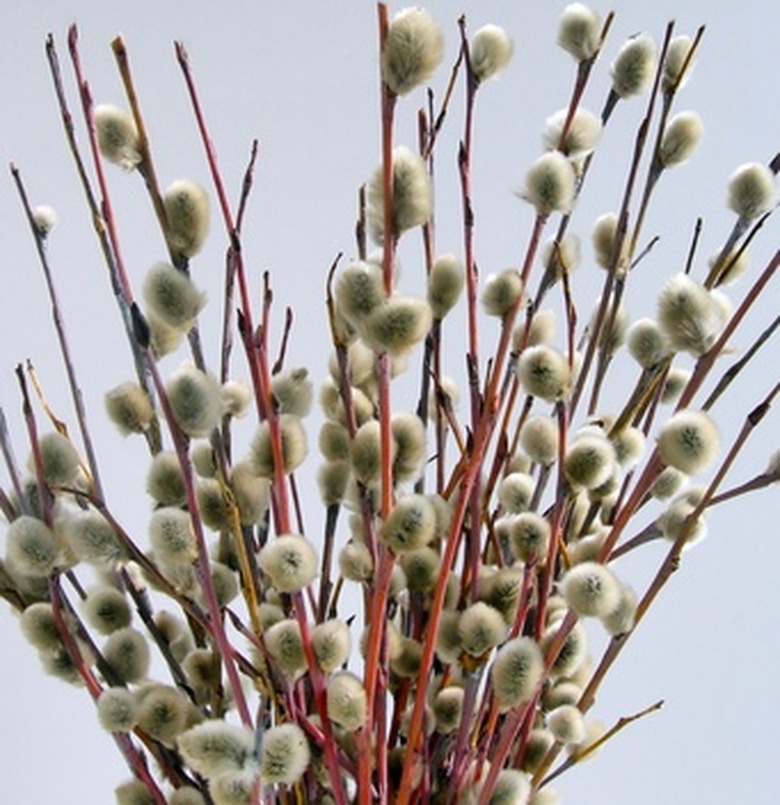How To Prune A Salix
The plant genus Salix includes almost 400 species of deciduous trees and shrubs, more commonly known as willows. Willows can grow at a rapid rate of several feet in a single year. There are many beneficial reasons to prune your salix: to create a fuller, bushier tree or shrub; to control the size of the willow; or to produce more colorful branches from new growth. Salix flowers are referred to as pussy willows and form on last years' growth. Therefore, pruning should not be done until after your salix blooms, if you wish to have pussy willows. Otherwise, a salix can be pruned any time during the year.
Shrubs
Step 1
Prune out all dead, scraggly or diseased rods or branches from the salix shrub. This can be done at any time of the year. Make the pruning cut as close to the healthy part of the branch as possible.
- The plant genus Salix includes almost 400 species of deciduous trees and shrubs, more commonly known as willows.
- Therefore, pruning should not be done until after your salix blooms, if you wish to have pussy willows.
Step 2
Decide on the shape you would like your salix bush to be. Depending on the species, your salix will have a certain natural shape, such as round, vase shape, wide spreading or arching, as examples.
Step 3
Prune misdirected branches and rods of the salix that do not conform to the shape of the bush you want. When pruning off branches and rods, hold your pruning shears with the blade on top, and have the blade close to the growth that is to remain. This technique alleviates any stubs or knobs on the remaining branch which would possibly sprout a new branch in an undesirable direction.
Step 4
Use your pruning shears to cut and trim the remaining branches and rods of the salix bush to the size you want. Shaping of the bush should be done in late winter. Make your pruning cuts directly above new bud formations in the late winter to control the length and size of remaining branches and rods.
- Decide on the shape you would like your salix bush to be.
- When pruning off branches and rods, hold your pruning shears with the blade on top, and have the blade close to the growth that is to remain.
Trees
Step 1
Allow your salix tree to freely grow during the first year after you plant it. This will allow your salix to establish itself and give you an idea as to the natural shape of the tree.
Step 2
Cut out any dead, diseased, and scraggly branches and rods when you see them, throughout the year. To maintain the health of the salix, weak and diseased limbs should be removed as soon as you notice them. In general, salix is not prone to limbs dying or becoming diseased unless it has not received adequate water.
Step 3
Prune off the lower branches to create the trunk of the salix tree during the dormant period of winter. Hold the pruning shears, with the blade on top, as close to the main trunk as possible. Make the pruning cut so there is no stub or knob remaining which might resprout.
- Allow your salix tree to freely grow during the first year after you plant it.
- Prune off the lower branches to create the trunk of the salix tree during the dormant period of winter.
Step 4
Prune the top of the strongest branches and rod to a height of 3 to 10 feet, depending on your preference. A salix tree can grow 5 to 12 feet in height in a single year. Controlling its height annually will keep the salix in your landscape from overtaking other trees, bushes and plants. Larger and taller tree species of salix should only have the unwanted lower water sprout limbs that appear on the lower trunk of the tree pruned off, as well as any dead or diseased branches.
Step 5
Prune any branches and rods that are growing in an odd direction or crossing other branches. By removing misdirected branches and rods, you will be controlling the salix shape and opening up the interior of the tree for better air circulation and growth.
Tip
You can use the pruned off rods from your salix for new cuttings, crafts or floral arrangements.
